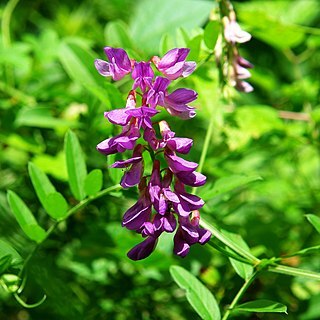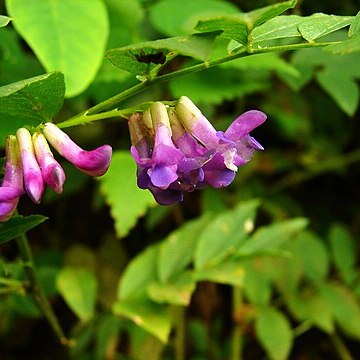Herbs perennial, 30-100(-180) cm tall, pilose, rarely densely white sericeous. Stem much branched, slender. Leaves subsessile, paripinnate, 5-12 cm; stipules semihastate, 8-20 mm, margin 3-or 4-toothed; leaflets 4-7-paired, elliptic to ovate-lanceolate, rarely oblong or lanceolate, 13-40 × 5-18 mm, adaxially appressed villous, apex rounded and retuse; lateral veins obvious; tendril 2-or 3-branched. Raceme usually longer than leaf, densely 10-20(-30)-flowered. Calyx obliquely campanulate, unequally toothed. Corolla blue, blue-purple, red-purple, or white; standard obovate, 10-16 × 5-6 mm, subequaling wings and longer than keel. Ovary glabrous; ovules ca. 6. Legume oblong, 18-28 × 4-6 mm, glabrous, both ends acuminate. Seeds 1-6. Fl. Apr-Sep, fr. Jul-Oct. 2n = 12, 14, 24.
More
A herb. It keeps growing from year to year. It grows 30-100 cm tall. The stems are slender and branched. The leaves have leaflets along the stalk. The leaves are 5-12 cm long. There are 4-7 pairs of leaflets and these are oval and 13-40 mm long by 5-18 mm wide. They are hairy underneath. There are 10-20 flowers in group. They are blue, purple, red or white. The pods are 18-26 mm long by 4-6 mm wide. There are 1-6 seeds.
Forests, forest margins, woods, scrub, dry slopes, grasslands, hills, hill slopes, riverbanks, sides of irrigation ditches, dry rocky banks, fixed sand dunes, fields, abandoned fields, wastelands, roadsides; at elevations to 4,000 metres.
More
It is a temperate climate plant. It grows in Inner Mongolia in China. It grows on dry slopes between sea level to 4,000 m above sea level across China. In Sichuan and Yunnan.
Can be grown by seedlings. Seeds needs soaking.


